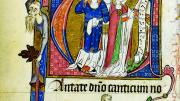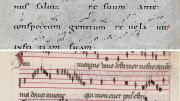“But we don’t have recordings from back then, do we?” We all have our own version of the stupidest question people might ask when they find out what we do. That one is mine. I study music in the fourteenth century; they didn’t have electricity, they didn’t have wax cylinders or records, there was no magnetized wire around, so—no. Biting back (usually) some sarcastic comment about the first generation iPod, I do my best to look empathetic and explain that we do not have audio recordings from back then. But what we do have is notated music, from the ninth century onward. At this point, some of my collocutors’ eyes glaze over because musical notation has an aura of arcana for the uninitiated, and the ninth century doubly so; others will look encouraged and ask whether it looks like today’s notation. Now we’re in business.
Thomas Forrest Kelly’s new book, Capturing Music: The Story of Notation, deftly covers three-quarters of a millennium to tell the story of how musical notation developed in the West. The earliest marks representing music will hardly look like notation in the sense in which we are used to seeing it—they look more like squiggles or punctuation marks (upper image in the second illustration above). The most recent of Kelly’s examples, from the early fifteenth century, contains all of the main ingredients for modern notation (lower image in the second illustration above). How scribes, composers, and singers got from the former to the latter is the question Kelly, who is Knafel professor of music [and a director of Harvard Magazine Inc.] sets out to answer in about 200 lively and engaging pages.
Western musical notation was developed for music with words—text-less instrumental music was not written down until the fourteenth century, and even then, very rarely. Kelly shows how the words themselves initially acted as a kind of music notation, because text gives some performers enough information to call a song to mind: “That boy took my love away.” Of course, this works only if you know the original Beatles song: when words were joined by “neumes” (the squiggles mentioned above), notation served to aid memory, not to replace it. This meant that the task of learning new songs involved transmission from one singer to another.
Over the course of the Middle Ages, the notation of pitch became more precise, eventually conveying enough information that singers not familiar with the repertory at hand could learn it. Sticking with our anachronistic example, here’s the story in synopsis:

It is tempting to fit such stories into a narrative of progress: medieval monks had no notation, then they started developing it, and eventually it morphed into the streamlined and powerful system we have today. (For an example of this kind of simplistic, teleological argument about an important concept in music, see Stuart Isacoff’s Temperament: How Music Became a Battleground for the Great Minds of Western Civilization.) But no real historian would make such a claim, and Kelly is as real as they get. He is careful to point out not only what is gained, but what is lost as notational systems change. This is especially true in his discussion of Guido of Arezzo, the twelfth-century monk who changed the course of notation by placing neumes onto the grid we now call a staff. Although Guido himself was far from modest about his achievements, Kelly reminds us that his foregrounding of pitch effectively precluded the notation of such nuances as articulation, pacing, and timbre—nuances whose absence from later chant notation has led to “the mindless plodding we are sometimes subjected to in modern performances of Gregorian chant.” The songs that tenth-century monks sang contained many subtleties that Guido’s notation gradually left behind.
From a contemporary perspective, this plodding comes about because chant notation does not give information about rhythm, leading some modern performers to give equal time to each note. Other performers do not—as long as there is only one melodic line, much flexibility remains. But notating rhythm becomes crucial once the chant is joined by a newly composed voice—and it is with polyphony, and with the development of rhythmic notation, that the second part of Kelly’s book concerns itself. During the thirteenth and fourteenth centuries, music notation gained in complexity and precision: from merely notating patterns of alternating long and short notes (like iambs or trochees in poetry) to having the ability to render pretty much any rhythmic pattern one could think of (and a few that are hard to imagine). For interested readers, Kelly explains how, exactly, these innovations work, but he also highlights the cultural and conceptual shifts that underlie them—shifts in performance ensemble, in the way time was perceived, in how books functioned in society.
Along the way we learn quite a lot about the music in question. Kelly gives an engaging account of the major developments in musical genres and styles through the early fifteenth century: from the “swirling” sound of thirteenth-century organum (a slowed-down plainchant melody with ornate new voices added on top), resembling “an enormous mosaic of light,” through the “highly structured” and “theoretically complex” motets of Philippe de Vitry, to the “sprightly, lively and surprising” rhythmic effects of later Italian repertories. This is no small feat, and it represents the most successful attempt to date at telling a broad history of medieval music in a publication primarily directed neither at specialists nor students. No interested reader will feel left behind by Kelly’s engagingly written and carefully laid-out narrative.
Beyond its informative and lively prose, Capturing Music is a sensory feast. The book is lavishly printed in full color and playfully designed, using elements borrowed from medieval illuminated manuscripts. There are colorful borders here, and illuminated miniatures; leaves curl around the page numbers in the margins. And the wealth of color images of music notation memorably illustrates the developments that Kelly’s text describes.
Then there’s the music. An audio CD accompanying the book contains 16 tracks newly recorded for this project by the Boston-based vocal ensemble Blue Heron, directed by Scott Metcalfe. These renditions bring to life the sounds Kelly’s prose evokes. The beautiful tracks hammer home a point Kelly makes repeatedly: were it not for notation, this centuries-old music would never have reached us. Listening to the sparkling and energetic renditions on the CD, we are glad that it did. What’s at stake, after all, is not just technicalities about where stems do or don’t go, but music—beautiful, challenging, ethereal or earthy, sacred and profane, deserving of our attention and admiration, and benefitting from repeated listening.
I have no doubt that Capturing Sound will make my life easier. As the first nontechnical book on the history of music notation, it fills a much-needed gap and will serve to educate general readers about the kinds of work music historians do. I expect fewer iterations of my least-favorite question from now on. But Kelly’s book will also change the valence of another question I often hear: “What can I read to give me an introduction to this stuff you study, something intended for an interested lay reader?” In the past I had no good answer. Forget notation—I could not think of a book covering any broad aspect of medieval music that was neither a textbook nor a publication aimed at specialists. But from now on I shall be able to reply confidently—knowing that I am recommending something as engaging as it is wise, as informative as it is fun—“Go read Thomas Forrest Kelly’s new book.”










